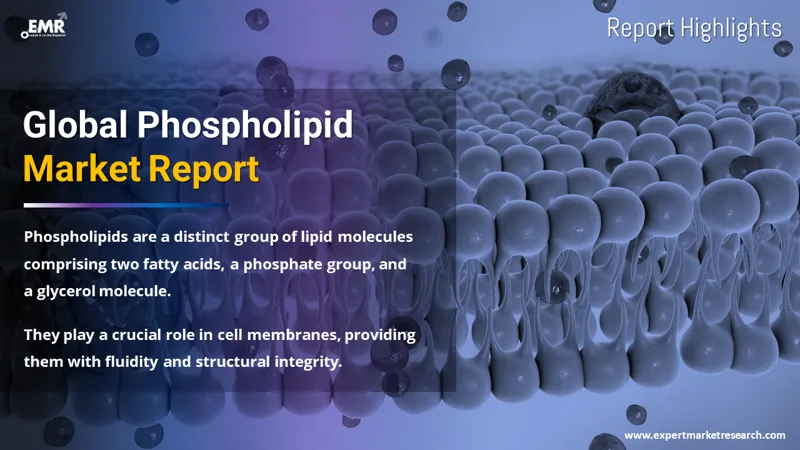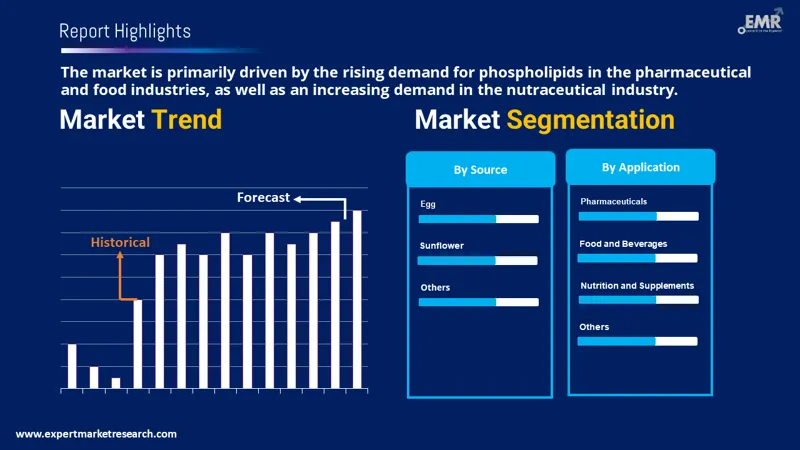
Consumer Insights
Uncover trends and behaviors shaping consumer choices today
Procurement Insights
Optimize your sourcing strategy with key market data
Industry Stats
Stay ahead with the latest trends and market analysis.
The global phospholipid market size reached a value of around USD 3.66 Billion in 2025. The market is further expected to grow at a CAGR of 7.60% between 2026 and 2035, reaching a value of around USD 7.61 Billion by 2035.
Base Year
Historical Period
Forecast Period
Compound Annual Growth Rate
7.6%
Value in USD Billion
2026-2035
*this image is indicative*
| Global Phospholipid Market Report Summary | Description | Value |
| Base Year | USD Billion | 2025 |
| Historical Period | USD Billion | 2019-2025 |
| Forecast Period | USD Billion | 2026-2035 |
| Market Size 2025 | USD Billion | 3.66 |
| Market Size 2035 | USD Billion | 7.61 |
| CAGR 2019-2025 | Percentage | XX% |
| CAGR 2026-2035 | Percentage | 7.60% |
| CAGR 2026-2035 - Market by Region | Asia Pacific | 8.2% |
| CAGR 2026-2035 - Market by Country | India | 8.1% |
| CAGR 2026-2035 - Market by Country | China | 7.9% |
| CAGR 2026-2035 - Market by Source | Soy | 8.4% |
| CAGR 2026-2035 - Market by Application | Pharmaceuticals | 8.6% |
| Market Share by Country 2025 | France | 4.1% |
A phospholipid is a specific class of lipid molecules that contains two fatty acids, a phosphate group, and a glycerol molecule. It is a key element of cell membranes that gives the membranes their fluid nature. In many different sectors, phospholipids are utilised as solubilisers, emulsifiers, wetting agents, and liposome formers.

Read more about this report - REQUEST FREE SAMPLE COPY IN PDF
The EMR’s report titled “Phospholipid Market Report and Forecast 2026-2035" offers a detailed analysis of the market based on the following segments:
Market Breakup by Source
Market Breakup by Application
Market Breakup by Region

Read more about this report - REQUEST FREE SAMPLE COPY IN PDF
The soy segment, by phospholipid source, witnessed significant growth in the phospholipids global market and is expected to maintain this growth during the forecast period as phospholipids are found naturally in soy. Food additives that are biologically active are frequently made from soy phospholipids, especially synthetic lecithin, thus fuelling the segment growth. The demand for soy-based phospholipids has also increased due to the rise in the need for natural products in the pharmaceutical and cosmetics sectors.
Asia Pacific is anticipated to be one of the fastest-growing regions in the phospholipid market due to increasing demand from various application industries. The widespread availability of raw materials including soy, sunflower, egg, rapeseed, and milk is incentivising small-scale producers to create ingredients with organically derived components for food and nutraceutical formulation which has increased the phospholipid market demand. Due to its health advantages, including the absorption of omega-3 fatty acids, phospholipid-based nutritional and health supplements have seen a considerable acceptance rate in countries such as India.
| CAGR 2026-2035 - Market by | Country |
| India | 8.1% |
| China | 7.9% |
| Canada | 7.6% |
| Saudi Arabia | 7.6% |
| UK | 7.3% |
| USA | XX% |
| Germany | 6.8% |
| France | XX% |
| Italy | XX% |
| Japan | XX% |
| Australia | XX% |
| Brazil | XX% |
| Mexico | XX% |
The comprehensive EMR report provides an in-depth assessment of the market based on Porter's five forces model, along with giving a SWOT analysis. The report gives a detailed analysis of the following key players in the global phospholipid market, covering their competitive landscape and the latest developments like mergers, acquisitions, investments, and expansion plans.
Avanti Polar Lipids, Inc., founded in 1969 is currently headquartered in Alabama in the United States. The company is focused on creating advanced lipid-based products and delivery methods to treat medical issues that cannot be addressed by currently available technology or pharmaceuticals.
Lecico GmbH is a highly specialised company that provides advanced lecithins made from milk, rapeseed, sunflower, and soy with a product line that includes liquid and powder lecithin in non-GMO or organic grade. The company was created in 2007 and has its headquarters in Hamburg, Germany.
Lipoid GmbH, founded in 1977 and headquartered in Ludwigshafen, Germany is one of the leading providers of phospholipids. It offers high purity natural, hydrogenated, as well as synthetic products and preformulations along with providing goods for the nutrition and cosmetic industries.
*Please note that this is only a partial list; the complete list of key players is available in the full report. Additionally, the list of key players can be customized to better suit your needs.*
Other market players include Cargill, Incorporated, The Archer-Daniels-Midland Company, Stern-Wywiol Gruppe GmbH & Co. KG, VAV Life Sciences Pvt Ltd, Kewpie Corp., and CHEMI S.P.A., among others.




*While we strive to always give you current and accurate information, the numbers depicted on the website are indicative and may differ from the actual numbers in the main report. At Expert Market Research, we aim to bring you the latest insights and trends in the market. Using our analyses and forecasts, stakeholders can understand the market dynamics, navigate challenges, and capitalize on opportunities to make data-driven strategic decisions.*
Get in touch with us for a customized solution tailored to your unique requirements and save upto 35%!
In 2025, the global market for phospholipid attained a value of USD 3.66 Billion.
The market for phospholipid is projected to grow at a CAGR of 7.60% between 2026 and 2035.
The market is estimated to witness healthy growth in the forecast period of 2026-2035 to reach USD 7.61 Billion by 2035.
The major drivers of the market include the increasing demand in the nutraceutical industry along with the high phospholipid demand across the pharmaceutical and food industries.
The increasing demand for natural health supplements, rising consumption of functional and convenience foods, and increasing awareness about environmental safety and human health are the key trends propelling the growth of the market.
The major regions in the market are North America, Europe, the Asia Pacific, Latin America, and the Middle East and Africa.
The various applications of phospholipids in the market are food and beverages, nutrition and supplements, and pharmaceuticals, among others.
The major players in the phospholipid market are Avanti Polar Lipids, Inc., Cargill, Incorporated, Lecico GmbH, Lipoid GmbH, The Archer-Daniels-Midland Company, Stern-Wywiol Gruppe GmbH & Co. KG, VAV Life Sciences Pvt Ltd, Kewpie Corp., and CHEMI S.P.A., among others.
Explore our key highlights of the report and gain a concise overview of key findings, trends, and actionable insights that will empower your strategic decisions.
| REPORT FEATURES | DETAILS |
| Base Year | 2025 |
| Historical Period | 2019-2025 |
| Forecast Period | 2026-2035 |
| Scope of the Report |
Historical and Forecast Trends, Industry Drivers and Constraints, Historical and Forecast Market Analysis by Segment:
|
| Breakup by Source |
|
| Breakup by Application |
|
| Breakup by Region |
|
| Market Dynamics |
|
| Competitive Landscape |
|
| Companies Covered |
|
Datasheet
One User
USD 2,499
USD 2,249
tax inclusive*
Single User License
One User
USD 3,999
USD 3,599
tax inclusive*
Five User License
Five User
USD 4,999
USD 4,249
tax inclusive*
Corporate License
Unlimited Users
USD 5,999
USD 5,099
tax inclusive*
*Please note that the prices mentioned below are starting prices for each bundle type. Kindly contact our team for further details.*
Flash Bundle
Small Business Bundle
Growth Bundle
Enterprise Bundle
*Please note that the prices mentioned below are starting prices for each bundle type. Kindly contact our team for further details.*
Flash Bundle
Number of Reports: 3
20%
tax inclusive*
Small Business Bundle
Number of Reports: 5
25%
tax inclusive*
Growth Bundle
Number of Reports: 8
30%
tax inclusive*
Enterprise Bundle
Number of Reports: 10
35%
tax inclusive*
How To Order

Select License Type
Choose the right license for your needs and access rights.

Click on ‘Buy Now’
Add the report to your cart with one click and proceed to register.

Select Mode of Payment
Choose a payment option for a secure checkout. You will be redirected accordingly.
Gain insights to stay ahead and seize opportunities.

Get insights & trends for a competitive edge.

Track prices with detailed trend reports.

Analyse trade data for supply chain insights.

Leverage cost reports for smart savings

Enhance supply chain with partnerships.

Connect For More Information
Our expert team of analysts will offer full support and resolve any queries regarding the report, before and after the purchase.
Our expert team of analysts will offer full support and resolve any queries regarding the report, before and after the purchase.
We employ meticulous research methods, blending advanced analytics and expert insights to deliver accurate, actionable industry intelligence, staying ahead of competitors.
Our skilled analysts offer unparalleled competitive advantage with detailed insights on current and emerging markets, ensuring your strategic edge.
We offer an in-depth yet simplified presentation of industry insights and analysis to meet your specific requirements effectively.
Share